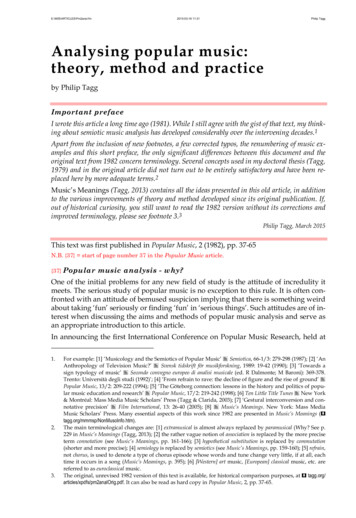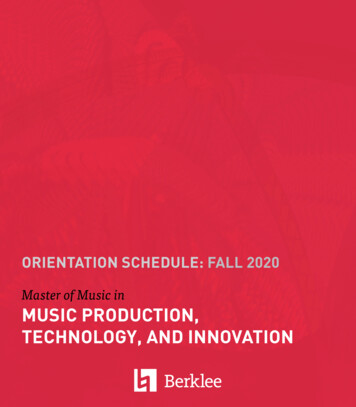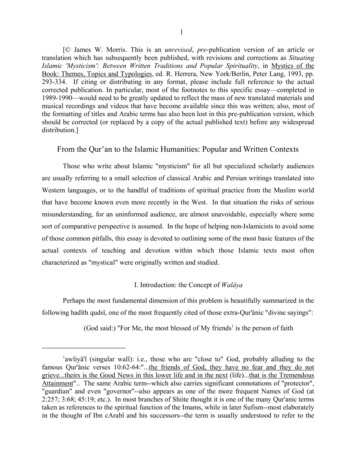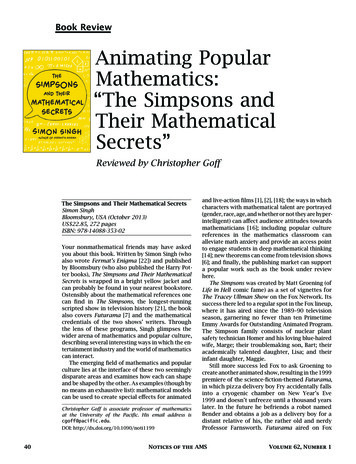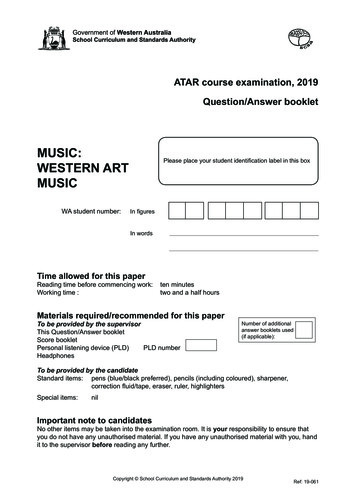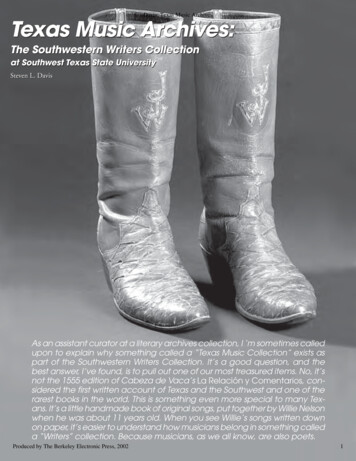
Transcription
POPULAR MUSIC,STARS ANDSTARDOM
POPULAR MUSIC,STARS ANDSTARDOMEDITED BY STEPHEN LOY, JULIE RICKWOODAND SAMANTHA BENNETT
Published by ANU PressThe Australian National UniversityActon ACT 2601, AustraliaEmail: anupress@anu.edu.auAvailable to download for free at press.anu.edu.auA catalogue record for this book is available from the National Library of AustraliaISBN (print): 9781760462123ISBN (online): 9781760462130WorldCat (print): 1039732304WorldCat (online): 1039731982DOI: 10.22459/PMSS.06.2018This title is published under a Creative Commons Attribution-NonCommercialNoDerivatives 4.0 International (CC BY-NC-ND 4.0).The full licence terms are available odeCover design by Fiona Edge and layout by ANU PressThis edition 2018 ANU PressAll chapters in this collection have been subjected to a double-blind peer-review process,as well as further reviewing at manuscript stage.
ContentsAcknowledgements . . . . . . . . . . . . . . . . . . . . . . . . . . . . . . . . . . . . . . . viiContributors. . . . . . . . . . . . . . . . . . . . . . . . . . . . . . . . . . . . . . . . . . . . . ix1.Popular Music, Stars and Stardom: Definitions, Discourses,Interpretations . . . . . . . . . . . . . . . . . . . . . . . . . . . . . . . . . . . . . . . 1Stephen Loy, Julie Rickwood and Samantha Bennett2.Interstellar Songwriting: What Propels a Song BeyondEscape Velocity? . . . . . . . . . . . . . . . . . . . . . . . . . . . . . . . . . . . . 21Clive Harrison3.A Good Black Music Story? Black American Starsin Australian Musical Entertainment Before ‘Jazz’. . . . . . . . . . . . 37John Whiteoak4.‘You’re Messin’ Up My Mind’: Why Judy Jacques Avoidedthe Path of the Pop Diva. . . . . . . . . . . . . . . . . . . . . . . . . . . . . . . 55Robin Ryan5.6.Wendy Saddington: Beyond an ‘Underground Icon’. . . . . . . . . . 73Julie RickwoodUnsung Heroes: Recreating the Ensemble Dynamicof Motown’s Funk Brothers. . . . . . . . . . . . . . . . . . . . . . . . . . . . . 95Vincent Perry7.When Divas and Rock Stars Collide: InterpretingFreddie Mercury and Montserrat Caballé’s Barcelona. . . . . . . . 115Eve Klein8.Intimacy, Authenticity and ‘Worlding’ in Beyoncé’sStar Project . . . . . . . . . . . . . . . . . . . . . . . . . . . . . . . . . . . . . . . 137Phoebe MacrossanIndex . . . . . . . . . . . . . . . . . . . . . . . . . . . . . . . . . . . . . . . . . . . . . . . . 153
AcknowledgementsThe authors would like to thank Emily Hazlewood and the editorial staffat ANU Press, as well as the members of the ANU Press Humanities &Creative Arts Editorial Board, for their work in bringing this book tofruition. We would also like to extend our thanks and appreciation to theanonymous peer reviewers, those who reviewed individual contributionsand those who were engaged by ANU Press to review. The feedback wereceived on both individual chapters and the draft manuscript was vital indeveloping our ideas. We would also like to extend our gratitude to bothANU Press and the ANU Humanities Research Centre for their generousfinancial support of this project, particularly Professor Will Christie. Wealso thank Fiona Edge of DesignEdge ACT for her creation of the coverimage for this volume. Finally, we would like to extend special thanks toeach of the authors for their innovative and insightful contributions to thecontinuing discourse on stars and stardom in popular music.vii
ContributorsSamantha Bennett is a sound recordist, guitarist and Associate Professorin music at The Australian National University. She is the author of twomonographs, Modern Records, Maverick Methods and Peepshow, a 33 1/3series edition (both Bloomsbury Academic). Samantha’s journal articlesare published in Popular Music, Popular Music and Society, The Journal ofPopular Music Studies and IASPM@journal.Dr Clive Harrison has performed with a stunning list of Australiancontemporary artists, and has recorded over 98 albums, 50 films and 3,500commercials. His 2016 PhD thesis was in creativity, multiple intelligencesand songwriting, and he is the Deputy Director, Academic Affairs, at theAustralian Institute of Music.Dr Eve Klein is a music technologist and popular music scholar, anoperatic mezzo soprano and a composer. Eve works at the University ofQueensland’s School of Music as Program Convenor of Popular Musicand Technology. Her current research explores classical music recordingpractices, popular–classical music hybridity, and technology-enabledperformance. Dr Stephen Loy is lecturer in music at the ANU School of Music,and has convened courses in music theory and aural skills, critical andhistorical musicology, and popular music studies. He has published on themusic of Louis Andriessen and Led Zeppelin.Phoebe Macrossan is a PhD candidate at the University of NSW, anda tutor in film studies at Queensland University of Technology. Her thesisexamines the utopian modalities of screen song across film, television andmusic video. She is a co-founder of the Sydney Screen Studies Networkand the Postgraduate Executive Member for the Screen Studies Associationof Australia and Aotearoa/New Zealand.ix
Popular Music, Stars and StardomDr Vincent Perry is a Brisbane-based drummer, record producer and avidcollector of vintage instruments and recording gear. In late 2017, Vincentreceived his PhD from Queensland Conservatorium, Griffith University.He is currently a sessional lecturer at JMC Academy where he teachesmusic, audio and entertainment business units.Dr Julie Rickwood is a music and performance researcher andpractitioner based in Canberra, Australia. Located at The AustralianNational University, her research has concentrated on popular musicand community choirs exploring intersections with music making suchas cross-cultural exchange and common ground, gender, identity, place,heritage and the environment.Dr Robin Ryan studied music at the University of Western Australia,the University of Washington and Monash University. She publishedon indigenous and popular music topics while a Research Fellow ofMacquarie University, Sydney (2001–05). Robin currently conductsecomusicological research through the Western Australian Academyof Performing Arts, Edith Cowan University.John Whiteoak is an Adjunct Professor in the Sir Zelman CowenSchool of Music, Monash University. He was co-editor for the CurrencyCompanion to Music and Dance in Australia (2003) and has publishedwidely on jazz related topics, including Playing Ad Lib, ImprovisatoryMusic In Australia, 1836–1970 (1999).x
1Popular Music, Stars andStardom: Definitions, Discourses,InterpretationsStephen Loy, Julie Rickwood and Samantha BennettWhat do we mean when we talk of ‘pop stars’ or ‘rock stars’? What dowe seek to convey when we describe a particular performer as a ‘popstar’? The use of the term ‘star’ to describe an individual’s outstandingachievement within a particular field may be traced as far back as theearly nineteenth century, when the term was used in popular discourseconcerning those who excelled in their fields, particularly in the theatreand the sporting arena (Oxford English Dictionary Online, 2016).The term gained a particular currency, however, with its use in describingthe most prominent and popular actors of the Hollywood film studiosduring the first half of the twentieth century. In this sense, the applicationof the word star connotes publicly recognised success, and it is often inthis manner that we apply the terms ‘pop star’ or ‘rock star’ to acclaimedperformers of popular music.However, our identification and veneration of stars, either of stage orscreen, is demonstrative of a complex web of social and cultural processes,which raises other questions, and invites comparisons with notions of fameand celebrity. In particular, the way a star’s persona may be understoodas both commercial commodity and an individualised, personalisedreflection of broader social or cultural meanings, invites questions of the1
Popular Music, Stars and Stardomways in which the star becomes ‘an object of cultural politics’ (Gledhill,1991, p. xiv). Here, notions of stardom intersect and overlap with thoseof celebrity.Whereas stardom is taken to derive from professional success and its popularrecognition, celebrity as a form of fame is more contested, particularly interms of its perceived value. Fred Inglis, in his A Short History of Celebrity,makes a historical distinction between renown, which is governed byand attributed to individuals based on position or achievement, and themore recent phenomenon of celebrity, which he argues is more transitory(Inglis, 2010, pp. 4–5). This sense that celebrity may be disconnected fromprofessional success in a field is further emphasised by Graeme Turner, whoargues that ‘the modern celebrity may claim no special achievements otherthan the attraction of public attention’ (Turner, 2014, p. 3). Similarly,Sean Redmond and Su Holmes note the at times derogatory connotationsof the term ‘celebrity’, which places it in a hierarchical relationship withthe notion of ‘stardom’: ‘the concept of the “star” [is] positioned abovethe concept of the celebrity—with its persistent association with fame asmore ubiquitous, and thus devalued, currency’ (Redmond and Holmes,2007, p. 8).While the term ‘star’ continues to be used to describe ‘those knownfor a public role in a particular profession’ (Redmond and Holmes,2007, p. 9), and, therefore, may be distinguished from the notion ofcelebrity as one who is ‘well-known for their well-knownness’ (Boorstin,1971, p. 58), Marsha Orgeron has noted the ‘categorical slipperiness’between these terms, and others such as ‘personality’ and ‘superstar’,with meanings shifting in response to developments in culture and itsdepiction (Orgeron, 2008, 190). Despite these particulars of definition,the role that stars play in the pervasive cultural, commercial and socialprocesses connected with popular culture mandates a consideration ofthe phenomenon in the context of these broader issues. Indeed, thedevelopment of academic disciplines around stardom and celebrity reflectsthe diversity of approaches that may be taken to its investigation.Critical discourses concerning stardom and celebrity date from the 1970s,arising initially as a component of the emergent film studies of the period.It was in examinations of the roles played by stars within the filmindustry, and their significance to audiences, that the field has its genesis.In particular, Richard Dyer’s book Stars, first published in 1979, proveda seminal work in the establishment of approaches to issues of stardom as2
1. Definitions, Discourses, Interpretationsthey related to the commercial and social processes of the film industry.Dyer’s was the first critical study of stardom in cinema that sought tointerrogate how stars, as images projected within film and via other ‘mediatexts’ and intersecting with their functional role as characters withinfilms, through both their on-screen characters and off-screen personae,informed and helped shape social and cultural ideas (Dyer, 1998, p. 1).Dyer’s critique of the ‘star image’ (Dyer, 1998, p. 129) and its role in thecreation of sociocultural meaning was further developed in his subsequentwork Heavenly Bodies: Film Stars and Society, in which he focused on thesignificant figures of Marilyn Monroe, Paul Robeson and Judy Garland toexplore the interrelationship of star construction and audience receptionin the creation of cultural meaning (Dyer, 2004).Dyer’s approach to the critique of stardom through the notion of the ‘starimage’ as a ‘media text’ set a critical frame for the exploration of the socialfunction of stardom within the entertainment industries, influencingmany subsequent studies. While acknowledging this debt, and firmlygrounded in the discipline of film studies, Christine Gledhill’s 1991collection, Stardom: Industry of Desire, brought together studies by a rangeof contributors from across the disciplines of cultural studies, media andcommunication studies, gender studies and politics, emphasising a beliefin the study of stardom as necessarily interdisciplinary. Gledhill (1991)writes in the introduction to the collection:The star challenges analysis in the way it crosses boundaries: a product ofmass culture, but retaining theatrical concerns with acting, performanceand art; an industrial marketing device, but a signifying element in films;a social sign, carrying cultural meanings and ideological values, whichexpresses the intimacies of individual personality, inviting desire andidentification; an emblem of national celebrity, founded on the body,fashion and personal style; a product of capitalism and the ideologyof individualism, yet a site of contest by marginalised groups; a figureconsumed for his or her personal life, who competes for allegiance withstatesmen and politicians. (p. xiii)This eloquent outline of the complex issues at play in stardom’s social andcultural functioning reflects the ways in which discourses in studies ofstardom and celebrity have subsequently developed, with a burgeoningof the field into a broad range of disciplines, particularly since the turn ofthe millennium.3
Popular Music, Stars and StardomOrgeron identifies three critical theoretical directions, which encompassmuch of the subsequent interdisciplinary diversity of the work conductedwithin stardom studies during the past two decades. Noting that‘the scholarship about media celebrity is diffuse in terms of both its breadthand its disciplinary focus’, Orgeron identifies the key fields as ‘the work ofstardom’, approaches that further develop Dyer’s notion of t
In particular, Richard Dyer’s book Stars, first published in 1979, proved a seminal work in the establishment of approaches to issues of stardom as . 3 1 . DEFInItIonS, DISCoURSES, IntERPREtAtIonS they related to the commercial and social processes of the film industry. Dyer’s was the first critical study of stardom in cinema that sought to interrogate how stars, as images projected
